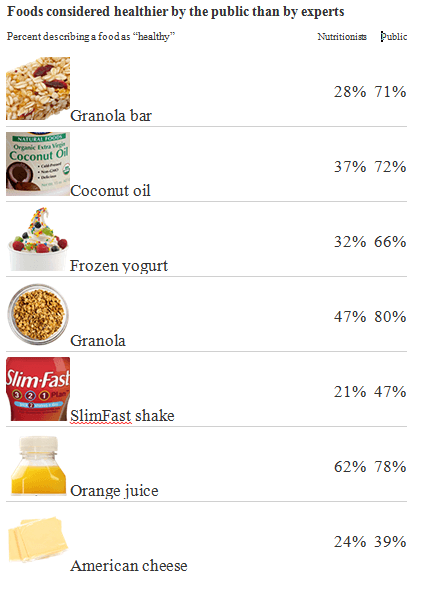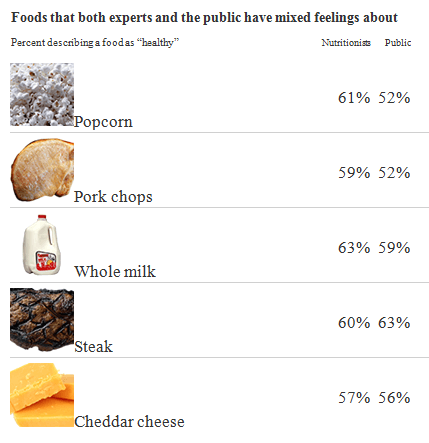French fries, bacon, chips, soda and chocolate bars are all poor food choices. We all know this. However, being able to decipher what is good for you and what isn’t–isn’t always so obvious. In fact, the New York Times recently published an article in which both average Americans and nutrition experts were polled on which of the 52 foods presented were good for you and which you should avoid. The results were all over the place. The general public’s views on which foods were healthy and which were not varied greatly from that of the experts on some food choices, but even more surprising was the fact that even the experts could not come to a consensus on quite a few food choices.
The public’s view of nutrient rich foods
The largest disparity uncovered by the poll was with granola bars. Are they healthy or not? Seventy-one percent of the public placed granola bars in the ‘nutrient rich foods’ category while only 28% of nutritionists did. Regular people tend to consider the nutritional value and fat content only when sorting foods into the ‘healthy’ and ‘unhealthy’ categories while food experts tend to have a broader perspective and include things like sugar and sodium content in their decisions. And for that reason, coconut oil, frozen yogurt, SlimFast shakes and orange juice topped the general public’s list of healthy but barely made it on the list of the experts.
Foods like sushi, humus, wine and shrimp were deemed healthy by the experts but the survey showed that while most of the Americans polled saw them as somewhat healthy, overall, they didn’t rank them quite as high. This fact leads the polling experts to believe that the media plays an enormous role in how the general public makes their food choices. Shrimp, for example, has received its fair share of bad press due to its high levels of cholesterol. Modern media shapes public opinion on many things–including healthy eating.
Disparities among the experts concerning nutrient rich foods
Experts opinions diverged the most when it came to steak, cheddar cheese, whole milk and pork chops. These are nutrient rich foods but the are high in saturated fat. Previously, it was common knowledge that fat–particularly saturated fat should be avoided at all costs. More recent studies render mixed views on the subject and experts are still grappling with the question if these food should be avoided or if they are indeed healthy.
Choosing foods that are good for you
The Federal Drug Administration(FDA) is currently updating its standards on which foods it deems healthy in light of new research concerning what our bodies need. This move underscores the notion that finding foods that are truly healthy is, at best, a moving target. Here are 3 easy things you can do to simplify the process of making healthy food choices and remove some of the frustrating guess work:
- Know your body and your own health needs. Understanding your health needs and choosing foods that work well with your body’s chemistry is key. Even though shrimp made the experts’ list of nutrient rich foods, if you have problems with cholesterol you may want to think twice before adding significant amounts of it to your diet. Being aware of your genetic makeup, the health history of your family, any predispositions to certain illnesses and your blood type all are key factors in how your body responds to and interacts with the foods you eat.
- KISS–“Keep it simple silly.” This saying definitely applies when it comes to your diet. Don’t overthink it. There are a few (and I do mean few) rules that you should follow when it comes to what you put in your body. The first is the less processed the better. Eating foods in their natural state with minimal additions of chemicals and manipulation is always a good idea. The second hard and fast rule is eat your greens. No matter who you talk to, the message is the same, leafy greens are the way to go. Adding leafy greens to your diet will have positive impacts on your overall health.
- Moderation is key. Eliminating entire food groups from your diet is never a good idea. Protein, complex carbohydrates and fats all play a role in keeping our bodies operating optimally. The key to healthy eating for both the body and the mind is to use moderation.
Food fads come and go, but the facts are clear: everyone does not have the same basic nutritional needs. We all know someone who is a strict vegetarian and their body thrives on that diet, while others swear by Atkins or similar low-carb plans however, those types of diets may not work for you. Get to know yourself and tailor your diet to your own individual needs.















































